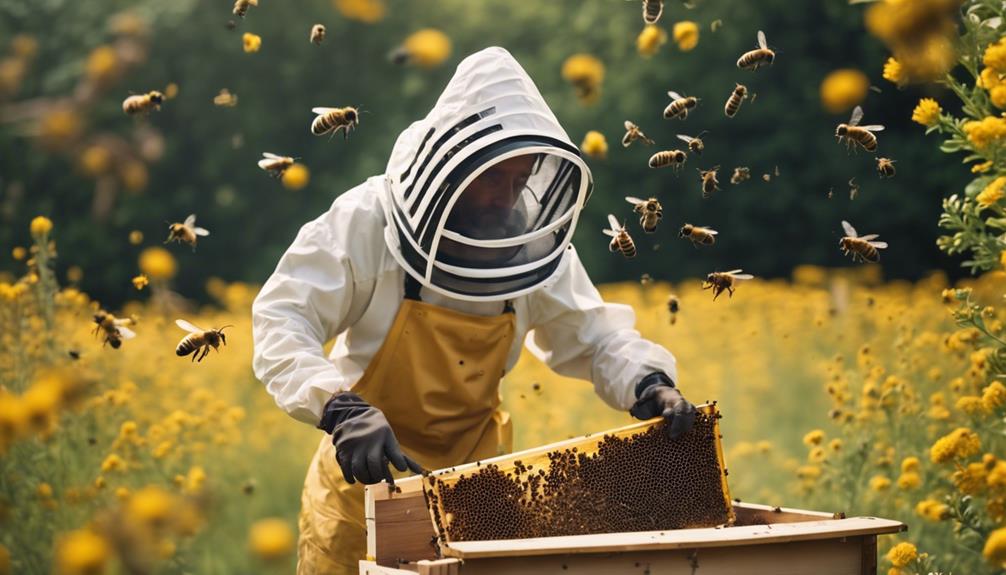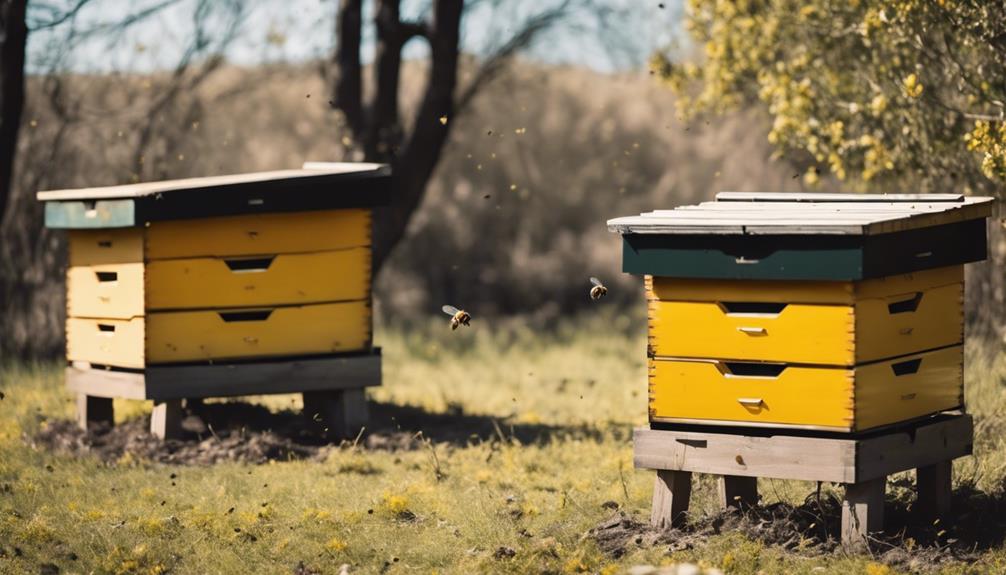In the realm of beekeeping, we’ve uncovered some neat alternatives to smoking bees that are bee-friendly! Utilizing sugar syrup sprays with ratios like 1:1 or 3/4:1 can help soothe our buzzing friends without the need for smoke. Incorporating a touch of Honey-B-Healthy or essential oils like lemongrass and lavender can amplify the calming effects even more. Vinegar, herbs like mint, and rosemary can also do wonders for relaxation. These gentle mixtures create a harmonious beekeeping experience that’s a win-win for everyone involved. Ready to discover new ways to keep bees chill?
Main Points
- Sugar syrup sprays mimic calming effects of smoke.
- Essential oils like lemongrass and lavender for bee calming.
- Vinegar and herbs such as mint and rosemary for relaxation.
- Liquid bee smokers for cooler, controlled smoke output.
- Promoting safer and efficient beekeeping practices.
Calming Sprays for Beekeeping
When conducting hive inspections, beekeepers can utilize sugar syrup sprays as a calming alternative to smoking bees. Mixing sugar syrup in ratios like 1:1 or 3/4:1 can effectively improve bees without the need for smoke.
This sugar water spray is a practical and efficient way to reduce disturbance during hive checks. By adding a product like Honey-B-Healthy to the syrup mixture, beekeepers can boost the calming effect on their bees.
Not only does this method minimize aggression in the hive, but it also provides a gentle way to keep bees calm and focused. Sugar syrup sprays have proven to be a reliable tool for beekeepers seeking a natural and effective way to manage their hives without the use of traditional smoking methods.
Natural Ingredients for Bee Calming
Exploring the soothing effects of natural ingredients on bees reveals a sustainable approach to hive management. Essential oils like lemongrass and lavender, known for their calming properties, can help create a peaceful environment for the bees.
Vinegar, when mixed with other substances, offers a natural way to relax these crucial pollinators. Herbs such as mint and rosemary, with their tranquil properties, contribute to bee well-being.
Combining these natural ingredients to make a gentle mixture, possibly with sugar water, can provide a harmonious setting for beekeeping activities. Opting for these natural solutions not only promotes a peaceful coexistence with bees but also aligns with eco-conscious practices.
Embracing these soothing alternatives enriches the beekeeping experience while respecting the bees’ freedom and natural instincts.
Benefits of Using Calming Solutions

We’ve all experienced the stress of managing bees during hive inspections, but there’s a natural solution that can help – calming solutions like sugar syrup.
Experienced beekeepers swear by the calming effects of sugar spray, making it a reliable alternative to smoke for soothing bees. Frederick Dunn and John from Baddest Bees YouTube channel advocate using 1:1 sugar syrup to manage bees effectively, as video evidence showcases successful hive inspections without the need for smoke.
Stress Relief Methods
Implementing calming solutions like sugar syrup is a beneficial method for reducing stress on bees during hive inspections. When we use sugar water, it acts as a gentle calming agent, helping maintain a peaceful hive environment. This approach can prevent aggressive behavior in bees, making interactions smoother for both beekeepers and bees.
The beauty of sugar syrup is that it mimics the calming effect of smoke without any harmful side effects. By incorporating these reassuring alternatives, we can guarantee that our hive inspections are stress-free and advantageous for the well-being of the bees.
Natural Relaxation Techniques
To enhance beekeeping practices and promote a harmonious hive environment, utilizing natural relaxation techniques such as sugar syrup can significantly benefit both beekeepers and bees. Calming our buzzing friends can be achieved by incorporating soothing additives like Honey-B-Healthy into sugar water solutions.
Instead of resorting to the smoker, consider gently misting the bees with a sugar syrup mixture to keep them relaxed during hive inspections. This gentle approach not only reduces bee disturbance but also creates a more peaceful interaction for all involved.
The calming effect of the sugar water mist can effectively soothe the bees without the need for smoke, making the beekeeping experience more enjoyable and stress-free.
Comparison With Traditional Smoking
Compared to traditional smoking methods, the liquid bee smoker produces cooler smoke, offering a more gentle approach that minimizes distress to the bees. When considering the differences between the two methods, here are some key points to keep in mind:
- Cooler Smoke: Liquid bee smoker produces cooler smoke, reducing the risk of harm to the bees.
- Ease of Transport: Liquid smoker is easier to handle and transport, making it more convenient during beekeeping tasks.
- Fuel Requirements: Traditional smokers need wood chips for fuel, while liquid smokers can be easily refilled.
- Controlled Smoke Output: Liquid smokers provide a more consistent and controlled smoke output, aiding in effective bee management.
These factors highlight the advantages of using a liquid smoker over traditional smoking methods, promoting a safer and more efficient beekeeping experience.
Reducing Stinging Incidents in Bees
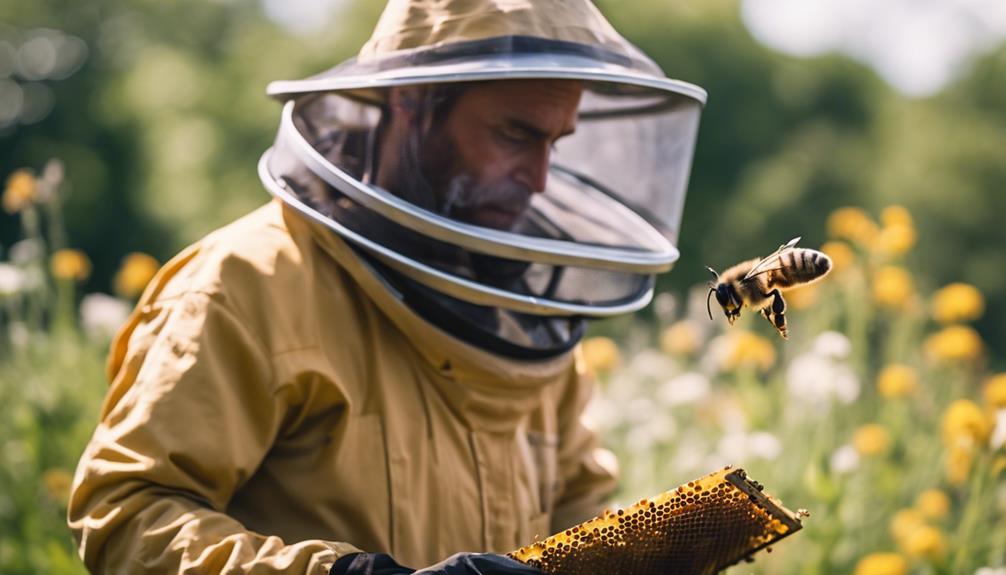
After highlighting the benefits of using a liquid smoker over traditional smoking methods in beekeeping, the focus now shifts to the effectiveness of reducing stinging incidents in bees through the use of smoke.
When conducting hive inspections, smoking bees can work wonders in keeping them calm and minimizing stinging episodes. The smoke interferes with bees’ alarm signals, curbing their defensive instincts and aggression levels. Surprisingly, exposure to smoke prompts bees to gorge on honey, which decreases their inclination to sting.
Sustainable Colony Management Options
When examining sustainable colony management options for bees, we need to contemplate:
- Eco-conscious hive techniques
- Organic pest control
- Holistic beekeeping practices
These methods not only benefit the bees but also contribute positively to the environment.
Eco-Friendly Hive Methods
Eco-friendly hive methods prioritize sustainable colony management practices to reduce environmental impact and promote eco-conscious beekeeping. In terms of sustainable beekeeping, there are several eco-friendly hive methods worth considering:
- Utilizing natural materials: Opting for eco-friendly materials in hive construction reduces waste and promotes a healthier environment.
- Conserving water: Implementing water-saving techniques in beekeeping operations helps minimize water usage and supports sustainable practices.
- Integrated pest management: By using natural pest control methods, such as introducing beneficial insects, we can reduce the reliance on harmful chemicals.
- Supporting biodiversity: Creating a habitat that fosters biodiversity not only benefits bees but also contributes to a thriving ecosystem.
These methods not only support bee health but also secure a greener future for our planet.
Organic Pest Control
Implementing organic pest control methods in beekeeping involves utilizing sustainable and eco-friendly approaches to manage pests effectively. By incorporating essential oils like lemongrass, mint, or lavender, beekeepers can deter pests without resorting to harmful chemicals that may harm the bees and the environment.
Integrated Pest Management (IPM) strategies, such as promoting natural predators, trap crops, and beneficial insects, offer a holistic approach to pest control in beekeeping. Opting for natural solutions over synthetic pesticides not only protects bee health but also helps maintain the balance of the ecosystem.
Sustainable colony management options prioritize the use of organic pest control methods, ensuring the well-being and productivity of the hive. Remember, in relation to beekeeping equipment, choosing sustainable and organic options can make a significant difference in the overall health of the colony.
Natural Beekeeping Practices
Natural beekeeping practices prioritize sustainable colony management through the exclusion of synthetic chemicals, emphasizing the well-being of bees and the environment. In the context of natural beekeeping, beekeepers focus on maintaining healthy hives in a way that mimics nature’s processes.
Here are some key elements of natural beekeeping practices:
- Organic Treatments: Using natural substances like essential oils and organic acids for hive health.
- Minimal Intervention: Allowing bees to follow their natural instincts with limited interference.
- Integrated Pest Management: Implementing strategies that control pests without harming bees.
- Habitat Conservation: Creating bee-friendly environments by planting diverse flowers and avoiding pesticide use.
Controlled Hive Inspection Techniques
During hive inspections, it’s important to cover frames not in use with boards or tea towels to prevent bee disturbance. By minimizing disruptions, we can guarantee a smoother inspection process and reduce stress on the colony.
When approaching the hive, employing techniques like gentle movements and minimal noise can help keep the bees calm. While traditional beekeepers may use a hot smoker to manage hive aggression, we can investigate alternative methods that balance effective hive management with bee well-being.
Quick inspections and calming methods can go a long way in maintaining harmony within the hive. Remember, a little consideration for our buzzing friends can lead to a more peaceful coexistence during hive inspections.
Minimizing Health Risks for Beekeepers
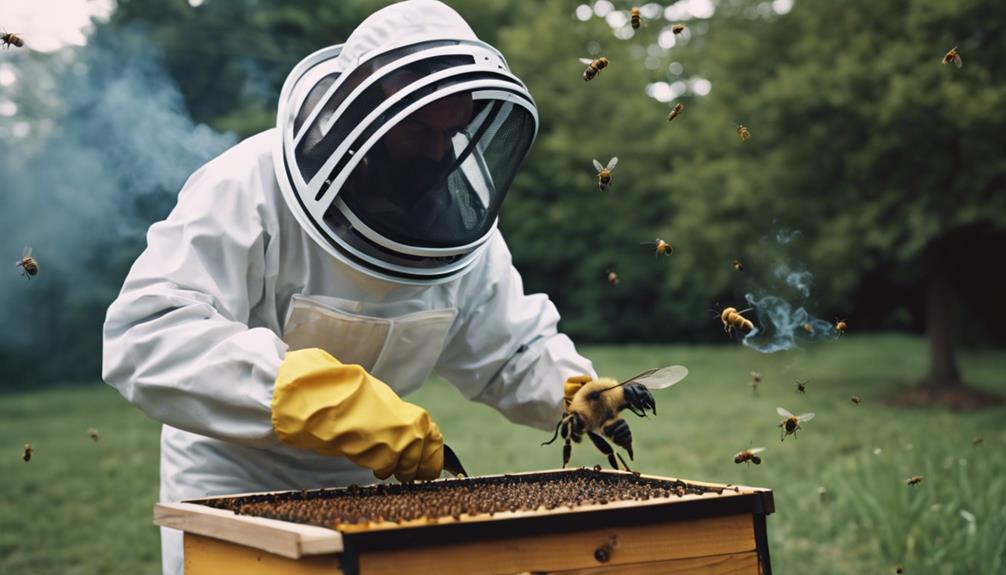
To prioritize the well-being of both bees and beekeepers, exploring alternatives like sugar syrup sprays instead of traditional bee smokers can significantly reduce health risks associated with beekeeping practices. Sugar syrup sprays offer a safe and effective way to calm bees during hive inspections without exposing beekeepers to harmful substances found in smoke. By opting for non-toxic alternatives, beekeepers can promote a healthier environment for themselves and their bees. Using a simple spray bottle filled with sugar syrup, beekeepers can gently manage their hives while minimizing the risk of long-term health issues associated with exposure to polycyclic aromatic hydrocarbons (PAHs) from traditional smokers.
- Sugar syrup sprays are non-toxic and safe for beekeepers.
- Using sugar syrup sprays reduces exposure to harmful substances in smoke.
- Promotes a healthier beekeeping environment for both bees and beekeepers.
- A simple spray bottle filled with sugar syrup is an effective alternative.
Targeted Approaches to Colony Control
In relation to colony control, targeted approaches are key.
By concentrating on hive inspection techniques and integrated pest management, beekeepers can effectively monitor and address issues within their colonies.
These methods not only help maintain the health of the bees but also contribute to the overall success of beekeeping practices.
Hive Inspection Techniques
In our hive inspections, we prioritize covering frames not in use to minimize disturbance and employ quick techniques to reduce disruption to the colony.
When approaching our bees, we focus on gentle movements and minimal disturbance to keep them calm.
Managing hive anger and aggression through targeted approaches during inspections is important for maintaining a harmonious environment.
It’s vital to balance the use of smoke alternatives with effective colony management strategies to guarantee the well-being of the bees and the productivity of the hive.
Integrated Pest Management
Utilizing targeted approaches, we employ Integrated Pest Management (IPM) to effectively control pests in our beehives. IPM offers a thoughtful alternative to smoking bees, focusing on sustainable pest control strategies. By identifying pests early and monitoring their populations, we can tailor specific measures to combat them.
Our IPM practices prioritize minimizing pesticide use, opting instead for physical barriers, biological controls, cultural practices, and selective chemical treatments when necessary. This comprehensive approach not only safeguards bee health but also protects the environment. With IPM, we aim to reduce pest damage while promoting a harmonious balance within the hive.
Embracing these methods empowers us to manage pests effectively without compromising the well-being of our precious bees.
Enhancing Beekeeping Practices
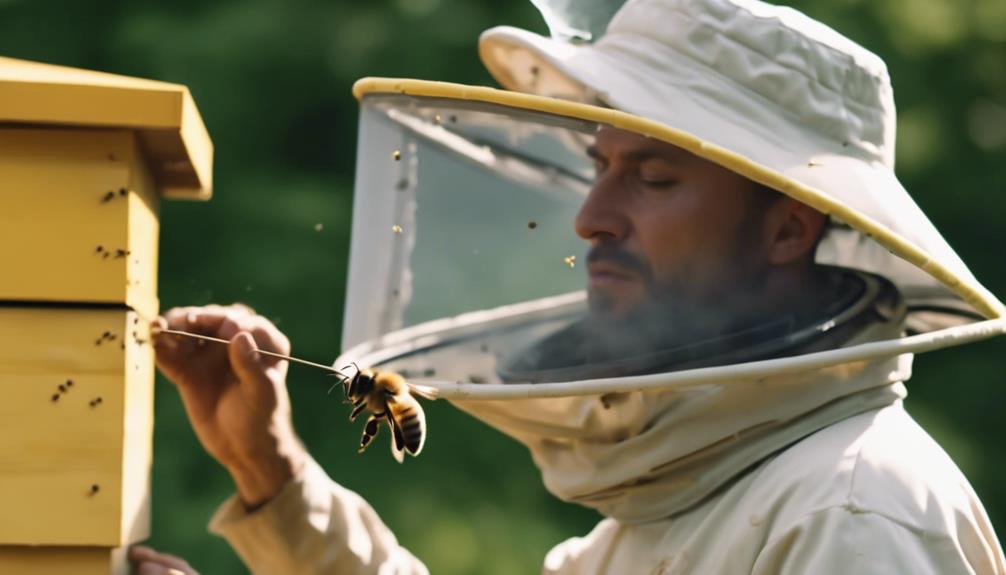
Improving beekeeping practices involves implementing innovative techniques like using sugar syrup as a calming alternative to smoking during hive inspections. This method not only keeps bees calm but also avoids the negative effects of smoke. Consider these points to elevate your beekeeping practices:
- Utilize 1:1 Sugar Syrup: Experts like Frederick Dunn and John from Baddest Bees YouTube channel recommend this ratio for effective calming.
- Draw Out Comb with Heavy Sugar Water: Feeding bees this mixture can help manage their behavior and encourage comb building.
- Experiment with Sugar Spray: Try this milder option to manage bees and reduce the discomfort associated with traditional smoking methods.
- Watch Videos for Inspiration: Video evidence showcases successful hive inspections using sugar water instead of smoke, providing practical insights for your own beekeeping journey.

Hello! My name is Noel Calvin. I graduated from UCLA and now work as a writer at Launch Ninjas. I write blog posts that inspire and guide our readers in their entrepreneurial pursuits. I live in Pleasantville, NJ, with a peaceful yet lively atmosphere that inspires me.
Writing stories is more than just a job for me. It allows me to share my observations and satisfy my curiosity about the world. I combine my analytical skills with creative enthusiasm to delve into technology trends and startup stories. But my life isn’t limited to screens and keyboards. I value loyalty, passion, and a touch of old-fashioned charm, which I infuse into every narrative I create.
I love spending time in my garage, jamming with my band when I’m not writing. Playing the guitar and singing bring me immense joy. I also enjoy capturing ordinary and extraordinary moments through my camera lens and exploring new culinary adventures that excite my taste buds. I’m always seeking new experiences.
My family is very important to me. Joyful Sunday brunches filled with laughter and intense board game nights keep me grounded, reminding me of life’s simple pleasures.
In my world, every moment is an opportunity for discovery. Every discovery is a story worth sharing, whether a heartfelt moment at home or the pulse of technological innovations. Join me as I navigate through life, one blog post, one guitar strum, and one heartwarming family dinner at a time.

